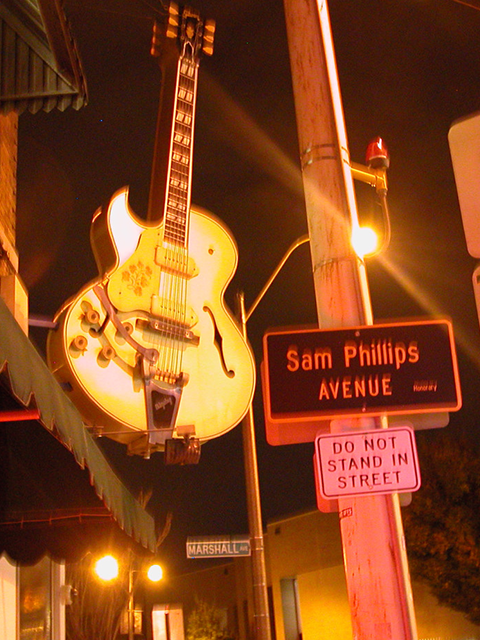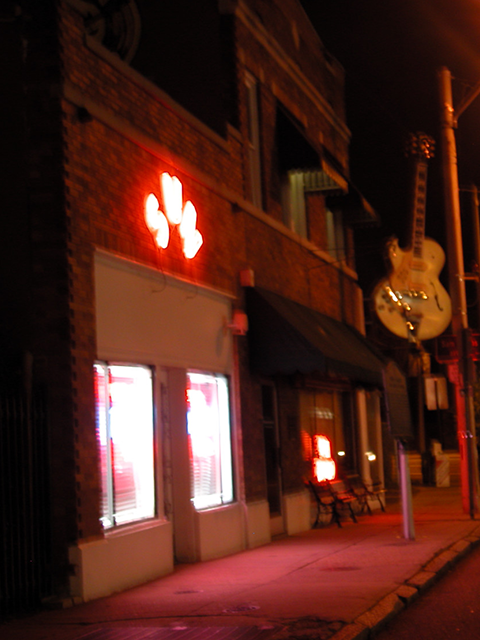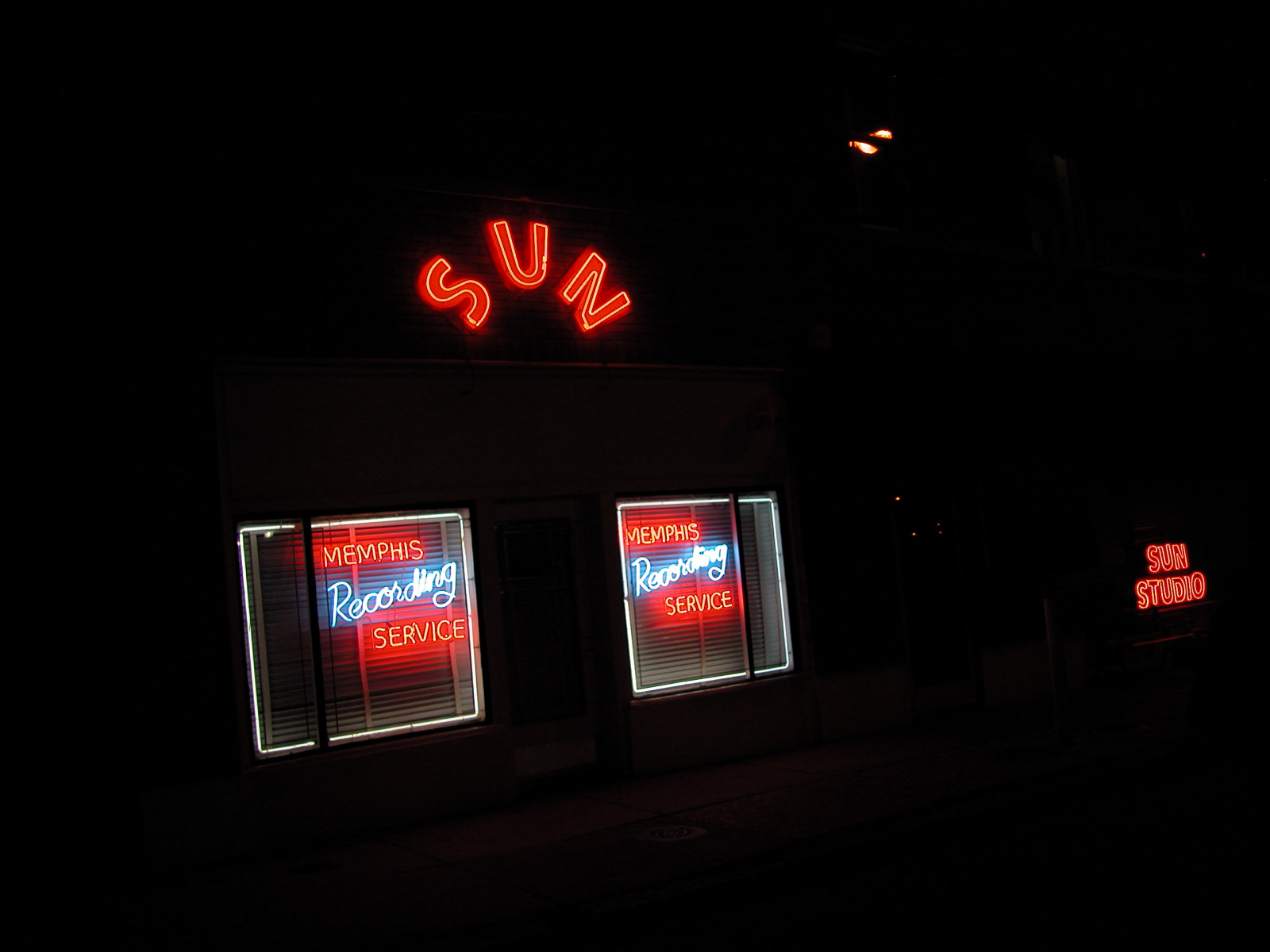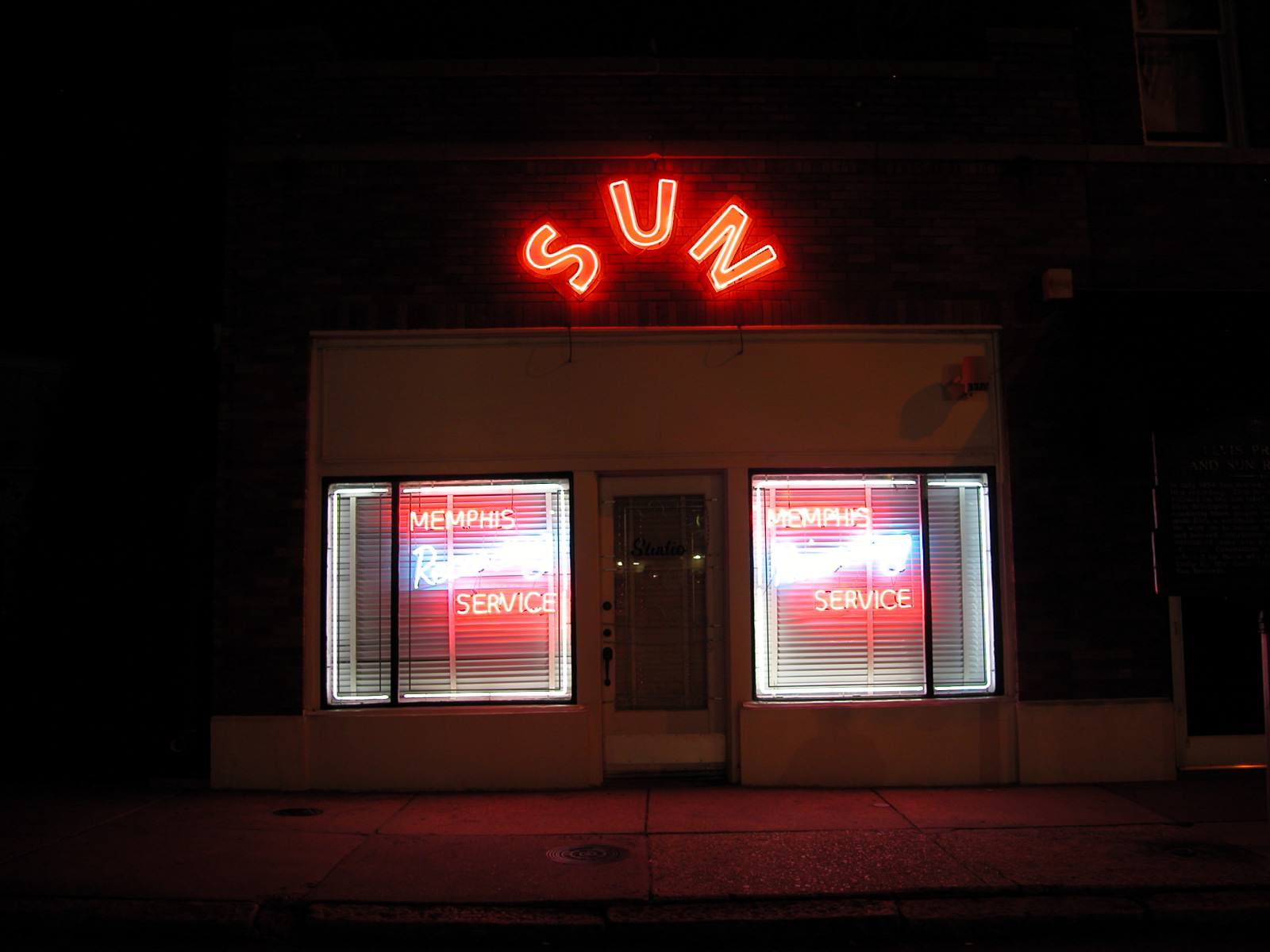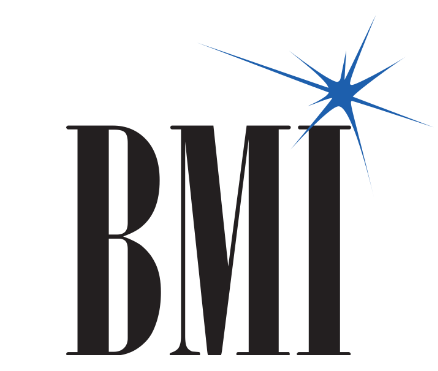Memphis Ghosts and Magic at 4am
Memphis Ghosts and Magic at 4 am
I had finished a show in Little Rock, Arkansas at The White Water Tavern and I was heading directly to Nashville that morning which is a few hours away, and I was taking Rt. 40 which goes directly from Little Rock to Nashville, and I was passing thru Memphis at around 4 am or so…
Memphis Ghosts and Magic were around the corner
I stopped at a large intersection and as I waited for the light to change, a chilly breeze blew right through one window and out the next and it was odd because it was August and it was hot enough to fry an egg on the pavement…and a cool breeze like that didn’t have any home that night and had no business being anywhere near this hot asphalt.
When that breeze left the car, it took the street lights with it; suddenly it got so dark and quiet that I knew something was about to happen; the change on the street was so dramatic you could sense it immediately… and I looked over to my left – and there it was. Sun Records.
When that breeze left the car, it took the street lights with it; suddenly it got so dark and quiet that I knew something was about to happen; the change on the street was so dramatic you could sense it immediately… and I looked over to my left – and there it was. Sun Records.
Elvis, Johnny Cash, Jerry Lee Lewis, Carl Perkins, Howlin’ Wolf... I swear all the ghosts were out that night and I could feel them in the dark… so I just left the car right there in the middle of the intersection and walked across the pavement and sat down in front of the door to this building and I just sat there – and I could feel someone there with me, too…right there on the pavement, right there in the middle of the street at 4 am in the morning and the feeling was intense but peaceful… and then I looked around me and the intersection was empty – not a living soul out that night, not a living soul out at that hour. There were no cars, no human forms, just me, and the neon sign…
I could feel someone there with me, too…right there on the pavement, right there in the middle of the street at 4am in the morning and the feeling was intense but peaceful… and then I looked around me and the intersection was empty – not a living soul out that night
So I got my camera out and carefully, deliberately, took a number of photos of the front and the sides and the corner of Sam Phillips Avenue.
But when I got home and looked at them a week later, every one of them was blurred, out of focus… except this one. And not a single car came through that intersection all the time I was there and it was so still and quiet it was unsettling… but I felt very peaceful and very, very much in the presence of the Gods.
Amen
Eric Sommer • August 24, 2009
The Sun Records Label Story
Sam C. Phillips was from Florence, Alabama. He had ambitions to be a lawyer but had to drop out of high school to support his aunt and widowed mother. He became a disc jockey in 1942 at WLAY in Muscle Shoals, Alabama. After a series of jobs on other radio stations, he ended up on WREC in Memphis, Tennessee, in 1946.
He was also promoting events at the Hotel Peabody in Memphis, and by 1950 had enough money to start a company to record local events and do custom recording. The company he formed was called Memphis Recording Service, with a small recording studio at 706 Union Avenue in Memphis. He developed contacts with Saul and Jules Bihari who owned Modern Records in Los Angeles and Sam’s first recording was of Phineas Newborn, a jazz pianist, for them in June 1950.
A disc jockey on WHBQ named Dewey Phillips (no relation to Sam) came to Sam with the proposal to form a record label to record the many blues singers in and around Memphis. Dewey Phillips would run the label and Sam Phillips would record the music.
The record was unsuccessful, and Sam Phillips subsequently negotiated a contract with Modern Records for Joe Hill Louis recordings.
The name of the record label was “It’s The Phillips” The first and only record issued was It’s The Phillips 9001/2, “Boogie in the Park”/”Gotta Let You Go” by Joe Hill Louis in August 1950. The record was unsuccessful, and Sam Phillips subsequently negotiated a contract with Modern Records for Joe Hill Louis recordings.
Phillips continued working for Modern Records, cutting sessions for B.B. King, Rosco Gordon and Walter Horton. In 1951, he also started an association with the Chess Brothers in Chicago. After recording Howlin’ Wolf and Jackie Brenston, he offered to lease the masters to Chess. Modern Records was upset that Phillips had given Chess the first option on Brenston and Wolf recordings and after that used virtually nothing from the Memphis Recording service.
Jackie Brenston was a saxophone player in Ike Turner’s Kings of Rhythm band. Ike Turner had come to the Memphis Recording Service to record an automobile song he and the band had developed called “Rocket 88“. Sam Phillips leased the song to Chess records, where it was issued under the name “Jackie Brenston and His Delta Cats.” It became one of the biggest R&B hits of 1951.
When many of the bluesmen that Phillips had been recorded migrated to Chicago and started recording with Chess Records directly, the Chess brothers also stopped using masters made by the Memphis Recording Service. The fact that he was unsuccessful in getting the material he was recording out through other record companies led Sam Phillips to start his own label. Sun Records was born in February 1952. Sam’s brother Judd Phillips joined the company to handle promotion.
Judd had been involved in country music promotion with Roy Acuff before moving to California to work on radio station publicly for Jimmy Durante. Judd knew how to get product exposure on radio. Judd eventually left Sun Records and had a short-lived label himself called Judd Records.
Judd knew how to get product exposure on radio. Judd eventually left Sun Records and had a short-lived label himself called Judd Records.
He was manager for Jerry Lee Lewis for many years. The first record on Sun was to be number 174 by “Little Walter” Horton and Jack Kelly titled “Blues in My Condition” [billed as by “Jackie Boy and Little Walter”] but a negative reaction to samples circulated to radio stations persuaded Phillips not issue the record commercially.
The first record on Sun was to be number 174 by “Little Walter” Horton and Jack Kelly titled “Blues in My Condition” [billed as by “Jackie Boy and Little Walter”] but a negative reaction to samples circulated to radio stations persuaded Phillips not issue the record commercially.
Sun 175 by Johnny London titled “Drivin’ Slow” was the first record to appear in record stores. A local disc jockey on WDIA named Rufus Thomas had the first hit on Sun with a recording of “Bear Cat” (Sun 181) which was an answer record to Big Mama Thorton‘s popular R&B hit “Hound Dog”. The success of “Bear Cat” and the follow-up “Tiger Man” (Sun 188) enabled Phillips to get national distribution deals. Sam Phillips had further success with blues recordings by Little Junior Parker, Billy “The Kid” Emerson and Little Milton Campbell.
He also recorded a few group recordings, his most successful was by a group of inmates at the Nashville State Penitentiary who called themselves the “Prisonaires“. Their recording of “Just Walkin’ in the Rain” (Sun 186) written by lead singer Johnny Bragg was an R&B hit and in 1956 was made into a pop hit when Johnnie Ray released a cover on Columbia Records.
The Memphis Recording Service, in addition to recording bar mitzvahs, weddings and making off-the-air transcriptions for local radio stations, also recorded personal records for people walking in off the street. For four dollars they would record two songs.
A young truck driver in Memphis named Elvis Presley stopped in one day on his lunch hour to record a song for his mother’s birthday.
Sam Phillips was not there that day, so Marion Keisker, the Sun office manager, recorded Elvis. As Elvis sang the first song she decided to make a tape copy to play for Sam. She not only played the song for Sam Phillips but kept pushing Sam to use the young singer.
A young truck driver in Memphis named Elvis Presley stopped in one day on his lunch hour to record a song for his mother’s birthday.
Eight months later, in 1954, when he needed a singer for a song called “Without You”, Sam called Elvis Presley into the studio. Elvis was terrible on the song, so Phillips asked him what else he could do.
Elvis sang religious, gospel, western and even Dean Martin material. Elvis told Sam he was looking for a band and Sam put him in touch with Scotty Moore and Bill Black. Elvis rehearsed with Scotty and Bill and then went back to the Sun studios. The first song recorded was “I Love You Because” and some other country-oriented songs. During a break, Elvis, Scotty and Bill were messing around in the studio, Elvis was banging on a guitar and singing “That’s All Right, Mama” an old country blues song by Arthur “Big Boy” Crudup. When Sam Phillips heard this, he told Elvis to start over and he would record it. Sam Phillips recognized that in Elvis he had what he had been looking for, a white singer who sounded black. They knew that “That’s All Right, Mama” (Sun 209) would be the first single for Elvis Presley.
Sam Phillips recognized that in Elvis he had what he had been looking for, a white singer who sounded black. They knew that “That’s All Right, Mama” (Sun 209) would be the first single for Elvis Presley.
During the next few days, they recorded Bill Monroe’s “Blue Moon of Kentucky” for the second side of the single. Sam took a dub of the record to Dewey Phillips, Sam’s former business partner and top DJ on WHBQ. Dewey played the song over and over, listeners called in with their enthusiastic reaction. Dewey called Elvis into the studio for an on-air interview, emphasizing that Elvis was a graduate of
Humes High School. Dewey said later he wanted to get that out since many listeners thought Elvis was black and Humes was an all-white school.
Sam Phillips and his artists had merged white country music with black rhythm and blues to create a new sound. Elvis made five singles for Sun records, each of them combining a blues song on one side with a country song on the other, but both sung in the same vein. It was the beginning of Memphis Ghosts and Magic!
The fifth single, “I Forgot to Remember to Forget” (Sun 223), made it to #1 on the Country and Western charts (both juke box and best seller charts), while the flip, “Mystery Train,” made #11. Elvis’ dynamic stage shows were also creating a sensation all over the south.
Each release got more and more attention. His fourth single, “Baby Let’s Play House“/”I’m Left, You’re Right, She’s Gone” (Sun 217) made #5 on the Billboard Country and Western (disc jockey) charts and #10 on the C&W bestseller charts. The fifth single, “I Forgot to Remember to Forget” (Sun 223), made it to #1 on the Country and Western charts (both jukebox and bestseller charts), while the flip, “Mystery Train,” made #11. Elvis’ dynamic stage shows were also creating a sensation all over the south.
Elvis had a new manager named Colonel Tom Parker who wanted to take Elvis to a major record company. Sam Phillips knew that he couldn’t keep Elvis when his Sun contract expired, so he sold Elvis’ contract and all of Elvis Presley’s Sun recordings to RCA Victor for $40,000, split $35,000 for Sun Records and $5,000 to Elvis (which may have represented unpaid record royalties).
With the success of Elvis, other young country singers were drawn to Sun Records. Among them were Carl Perkins, Johnny Cash, Jerry Lee Lewis, Roy Orbison and Charlie Rich. Sam Phillips soon abandoned blues recording and concentrated on this new music
With the success of Elvis, other young country singers were drawn to Sun Records. Among them were Carl Perkins, Johnny Cash, Jerry Lee Lewis, Roy Orbison and Charlie Rich. Sam Phillips soon abandoned blues recording and concentrated on this new music, called rockabilly, a combination of “hillbilly” (as country music was then sometimes called) and rock & roll. Sun Records produced hit after hit.
Carl Perkins was on the verge of major stardom with “Blue Suede Shoes” (it reached #2 on the pop charts and #1 on the country charts, despite a cover version by the enormously popular Presley), but was involved in a serious automobile accident which left him unable to cash in on his popularity. Jerry Lee Lewis had two giant smashes in “Whole Lotta Shakin’ Goin’ On” and “Great Balls of Fire“.
Jerry Lee Lewis continued recording for Sun for several years but he never recovered from the bad publicly
On a tour of England, the newspapers revealed that Lewis had married a 13-year-old girl while not legally divorced from his previous wife. Lewis had to cut the tour short and come home, his career temporarily in ruins. Jerry Lee Lewis continued recording for Sun for several years but he never recovered from the bad publicity to have a hit of the magnitude of his first two.
He was able to revive his career later by moving into country music on the Mercury Record label. Johnny Cash was probably the most consistent record seller on Sun but left the label for Columbia in 1958.
In October of 1957, Sun Records established a subsidiary label called Phillips International. This label had successful releases by Charlie Rich, Carl Mann and Bill Justis. Sam Phillips opened a new studio in Memphis (at 639 Madison Ave.) in mid-1960, replacing the studio at 706 Union.
He also opened another studio on 17th Street in Nashville in February 1961. Both studios were popular, gaining revenue for the Phillips corporation by recording music for other labels in addition to Sun and Phillips International.
…the old studio on Union Street was for most of the years only equipped with monaural recorders. The new studio featured an upgrade to stereo machines…
The move to the new studio on Madison Avenue in Memphis was important for another reason. Apparently, the old studio on Union Street was for most of the years only equipped with monaural recorders. The new studio featured an upgrade to stereo machines, and the stereo material released from Sun mostly seem to have been recorded, or at least overdubbed, after the move.
The Sun Record material is perhaps the most reissued music in the history of the record business, with the amount of record releases far exceeding the original output. Singleton mined the Sun archives extensively, including releasing stereo masters, and almost all of the unissued material in the vaults now has been released.
The original issues of the albums on Sun, Phillips International, and Judd were all mono, to our knowledge. Reissues of these albums have turned up in rechanneled stereo, but it apparently wasn’t until the late 1960s that the original tapes were dug out and some of the original stereo issued on vinyl. It’s clear Memphis Ghosts and Magic had a hand in all of this.
A recent CD on the AVI/Sun label featuring Charlie Rich’s recordings from 1959 show that Sun’s Union Avenue studios did have some stereo capability before the move, but the stereo recordings from that era are few and far between.
Sun Records had become a major force, almost becoming a national label. Unfortunately, its slate of talent left the label one by one and wasn’t replaced by artists of similar stature or talent. By 1963, Sun was pretty much back to the status of a regional label.
Singleton recognized the value of the catalog and re-released the great Sun recordings on a series of albums on the Sun International label in the United States.
He also leased the recordings to other record companies around the world. The Sun Record material is perhaps the most reissued music in the history of the record business, with the amount of record releases far exceeding the original output. Singleton mined the Sun archives extensively, including releasing stereo masters, and almost all of the unissued material in the vaults now has been released.
By 1968, Sun was almost moribund, issuing very few singles. Sam Phillips had made a lot of money from the record business and even more from his other interests (he was an early investor in the Memphis based Holiday Inn hotel chain among other things).
On July 1, 1969, Sam Phillips sold the Sun Record label to Shelby S. Singleton, Jr., a very successful record producer for Mercury records. Singleton recognized the value of the catalog and re-released the great Sun recordings on a series of albums on the Sun International label in the United States.
Sun Records was first and foremost a singles label, only 12 albums were issued on Sun and another 8 on the Phillips International label.
He also leased the recordings to other record companies around the world. The Sun Record material is perhaps the most reissued music in the history of the record business, with the number of record releases far exceeding the original output. Singleton mined the Sun archives extensively, including releasing stereo masters, and almost all of the unissued material in the vaults now has been released.
Sun Records was first and foremost a singles label, only 12 albums were issued on Sun and another 8 on the Phillips International label. The only Sun albums that stayed in print past the early 1960s were the seven Johnny Cash albums. Because of the intense interest in the Sun label, many of the albums are very collectible.
The guitars used in many of these recordings have also gained in stature, some models reaching “legend” Status… and as hard to find as the original recordings.
Probably the rarest albums are two of the later releases on Phillips International,a great blues album by Frank Frost, PILP-1975 and an R&B album by Frank Ballard, PILP-1985. The most in-demand album on Sun itself is probably Sun LP-1225, Dance Album of Carl Perkins.
This album was reissued with a new cover and a new title, Teen Beat. The Teen Beat cover may be even rarer than the Dance Album cover. The following discography covers the original albums on Sun and Phillips International, the albums released on Shelby Singleton’s Sun International label. Also included are the albums of reissued Sun material from around the world, although we’re sure this listing is not complete. The discography of Judd Records which was owned by Sam Phillips’ brother Judd Phillips is also included.
This discography was compiled using our record collections and the following books: The Sun Records Story, Catalyst, Sun Records: The Brief History of the Legendary Record Label, and Good Rockin’ Tonight: Sun Records and the Birth of Rock ‘N’ Roll, all by Colin Escott and Martin Hawkins, Elvis, A Biography by Jerry Hopkins, and The American Record Label Directory and Dating Guide, 1940 – 1959 by Galen Gart.
______________________________________________________
Eric Sommer: About the Artist
“If there’s a place for musical perfection, it’s wherever you’ll find Eric Sommer – A blistering acoustic style plus a variety of slide and open tuning formats will knock you for a loop…” wrote Studdie Burns, New Melody Maker/UK in 2013. “How one guy can do this so well is remarkable, but if you look a little deeper there’s a batch of road miles around this lad… and it all makes sense.”
Eric started his musical career in the Boston area under the eye of legendary promoter Don Law and was onstage at The Paradise Theatre in Boston for a record 40 appearances. He has been a regular player on many national and international tours and showcases, and worked in Europe for two years with Nick Lowe and acts Bram Tchaikovsky and Wreckless Eric; during this period Eric worked on Danish, German and British rock stages, returned to Boston and formed The Atomics.
As a founding member of Boston’s legendary pop/new wave cult trio “The Atomics”, who toured non-stop with Mission of Burma, Gang of Four and The Dead Kennedy’s and were on the leading edge of several musical transformations, Eric never lost sight of his acoustic roots, returning to his heroes and mentors often: David Bromberg, Steve Howe(YES), Duane Allman (Allman Bros.), Bert Jansch, Davy Graham, Robert Johnson. Mr. Sommer’s current project with power trio “The Solar Flares” shake up Chet Atkins and David Bromberg’s influences with those of Randy Travis and British Rocker Elvis Costello – a remarkable mix.
And to keep track of it all, Eric started keeping notes, which evolved from napkin scribbles to paper and pen efforts, writing stories, making poetry and capturing the roads and bridges as they went by, plus people, places and… more people which become his notes, then become characters for songs, stories, and prose.
Eric currently has four volumes of verse, 5 studio albums, a LIVE in AUSTIN DVD as well as an electronica project titled “The Smallest Particle” and more on the way… this blog is an attempt to keep track of it all…
Amen.
_________________________________
You can reach Eric directly at ericATericsommer.com and see more of his projects here on this website. Red Chairs, Black Pancake and Blue Turtle are all available here, as well as all current releases. Please share and comment below.
-

Singer/songwriter Eric Sommer is an unbelievable intersection of improbable influences and experiences channeled into an amazingly diverse catalog and a résumé that reads more like a musical adventure novel than a series of career bullet points.

